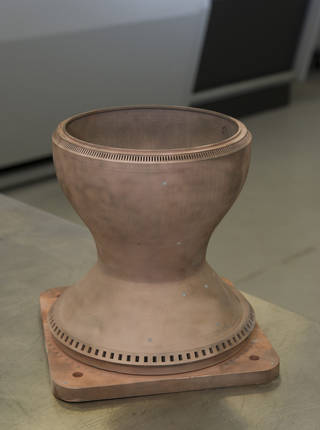
AS9100 Certification Sets MTI Apart From Additive Manufacturing Companies
April 23, 2015Going Green | Part 2
April 28, 2015NASA Achieves Historical Innovation For Aerospace Additive Manufacturing
NASA Marshall Space Flight Center in Huntsville, Alabama has reached the brink of aerospace additive manufacturing innovation by producing a 3D printed, full scale, copper rocket engine part. The build took 10 days and 18 hours to complete, and incorporated 8,255 layers of copper powder. Here at MTI, we love to see organizations like NASA looking to aerospace additive manufacturing as a cost-effective, timely alternative.
According to Steve Jurczyk, associate administrator for the Space Technology Mission Directorate at NASA headquarters in Washington, the completion of this rocket part is just the beginning. Jurczyk said,
“Building the first full-scale, copper rocket part with additive manufacturing is a milestone for aerospace 3D printing. Additive manufacturing is one of many technologies we are embracing got help us continue our journey to Mars and even sustain explorers living on the Red Planet.”
Copper was selected as the material of choice because if its excellent ability to conduct heat. For this reason, it was the chosen material for lining an engine combustion chamber. While copper’s ability to conduct heat makes it ideal for the use in engine combustion chamber, this unique property also produces some challenges when it comes to the additive manufacturing of copper. At this time, there are very few copper rocket parts that have been made with additive manufacturing.
NASA’s Vision For The Future Of Aerospace Additive Manufacturing
For NASA, creating the first 3D printed, full scale, cooper rocket engine part is just the beginning of the Low Cost Upper Stage-Class Propulsion Project funded by NASA’s “Game Changing Development Program” in the Space Technology Mission Directorate. Chris Protz, the Marshall propulsion engineer leading the project, said:
“Our goal is to build rocket engine parts up to 10 times faster and red cost by more than 50 percent. We are not trying to just make and test one part. We are developing a repeatable process that industry can adopt to manufacture engine parts with advanced designs. The ultimata goal is to make building rocket engines more affordable for everyone.”
The next steps in this project include sending the copper liner to NASA’s Langley Research Center in Hampton, Virginia, where a nickel super-alloy structural jacket with be directly deposited onto the outside of the copper liner. From there, the engine part will be hot-fire tested in order to ascertain the engine’s ability to perform under extreme temperatures and pressures.
About Metal Technology (MTI)
With more than forty years of experience applying innovative, proprietary technologies, Metal Technology (MTI) is making possible the use of difficult alloys for a wider range of applications with greater efficiency, versatility, and reliability. Alloys include Tantalum, Niobium, Zirconium, Titanium, Tungsten and Molybdenum. MTI uses specialized deep-draw, spinning, forging, machining, EDM, and additive manufacturing methods to deliver superior products according to your exacting specifications.
Contact us for more information on our aerospace additive manufacturing intitiatives.


